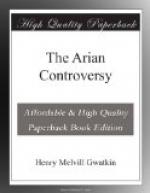[Sidenote: Arius himself.]
Arianism is Christianity shaped by thoughts like these. Its author was no mere bustling schemer, but a grave and blameless presbyter of Alexandria. Arius was a disciple of the greatest critic of his time, the venerated martyr Lucian of Antioch. He had a name for learning, and his letters bear witness to his dialectical skill and mastery of subtle irony. At the outbreak of the controversy, about the year 318, we find him in charge of the church of Baucalis at Alexandria, and in high favour with his bishop, Alexander. It was no love of heathenism, but a real difficulty of the gospel which led him to form a new theory. His aim was not to lower the person of the Lord or to refuse him worship, but to defend that worship from the charge of polytheism. Starting from the Lord’s humanity, he was ready to add to it everything short of the fullest deity. He could not get over the philosophical difficulty that one who is man cannot be also God, and therefore a second God. Let us see how high a creature can be raised without making hint essentially divine.
[Sidenote: His doctrine; Its merits.]
The Arian Christ is indeed a lofty creature. He claims our worship as the image of the Father, begotten before all worlds, as the Son of God, by whom all things were made, who for us men took flesh and suffered and rose again, and sat down at the right hand of the Father, and remains both King and God for ever. Is not this a good confession? What more can we want? Why should all this glorious language go for nothing? God forbid that it should go for nothing. Arianism was at least so far Christian that it held aloft the Lord’s example as the Son of Man, and never wavered in its worship of him as the Son of God. Whatever be the errors of its creed, whatever the scandals of its history, it was a power of life among the Northern nations. Let us give Arianism full honour for its noble work of missions in that age of deep despair which saw the dissolution of the ancient world.
[Sidenote: Its real meaning.]




